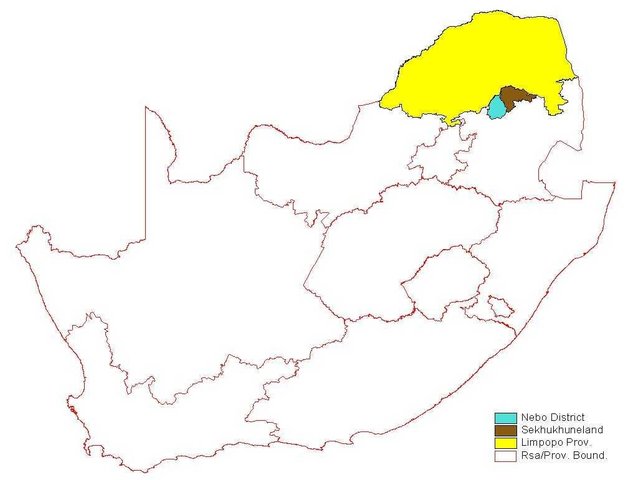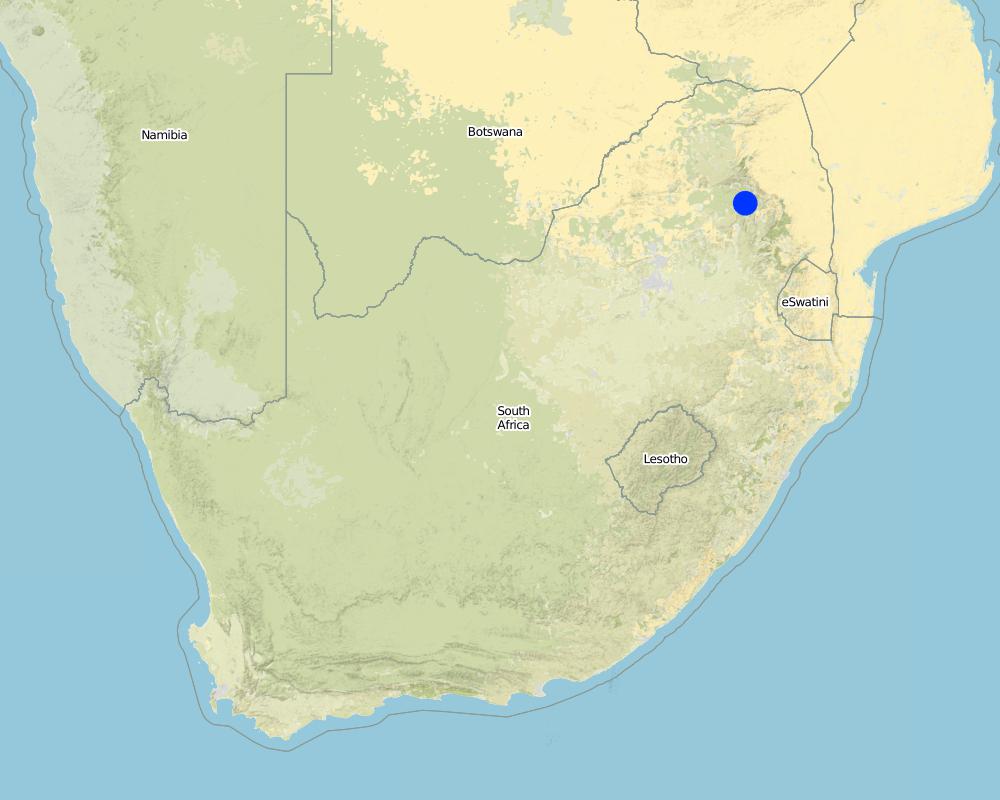Gully control (gabions) at Maandagshoek [แอฟริกาใต้]
- ผู้สร้างสรรค์:
- การอัพเดท:
- ผู้รวบรวม: Igmé Wilhelm Terblanche
- ผู้เรียบเรียง: –
- ผู้ตรวจสอบ: David Streiff, Alexandra Gavilano
Donga control, Maandagshoek Soil Conservation Project
technologies_1378 - แอฟริกาใต้
ดูส่วนย่อย
ขยายทั้งหมด ย่อทั้งหมด1. ข้อมูลทั่วไป
1.2 รายละเอียดที่ติดต่อได้ของผู้รวบรวมและองค์กรที่เกี่ยวข้องในการประเมินและการจัดเตรียมทำเอกสารของเทคโนโลยี
ชื่อขององค์กรซึ่งอำนวยความสะดวกในการทำเอกสารหรือการประเมินเทคโนโลยี (ถ้าเกี่ยวข้อง)
Action Green Heritage (Action Green Heritage) - แอฟริกาใต้1.3 เงื่อนไขการใช้ข้อมูลที่ได้บันทึกผ่านทาง WOCAT
ผู้รวบรวมและวิทยากรหลักยอมรับเงื่อนไขเกี่ยวกับการใช้ข้อมูลที่ถูกบันทึกผ่านทาง WOCAT:
ใช่
1.5 Reference to Questionnaire(s) on SLM Approaches (documented using WOCAT)

Interactive community approach, biodiversity increase. [แอฟริกาใต้]
Community involvement
- ผู้รวบรวม: Igmé Wilhelm Terblanche
2. การอธิบายลักษณะของเทคโนโลยี SLM
2.1 การอธิบายแบบสั้น ๆ ของเทคโนโลยี
คำจำกัดความของเทคโนโลยี:
Stone walls and re-vegetation (planting of indigenous trees) = Rehabilitation
2.2 การอธิบายแบบละเอียดของเทคโนโลยี
คำอธิบาย:
For the pilot project loose stones and sometimes concrete walls that work well were used. It is not more expensive than gabions, because a trucker is needed for gabions and it is labour intensive. Wire is also often stolen off the gabions.
The following steps were followed in this technology:
The areas are fenced, barricades (gabion like structure) erected, and planting done. Rehabilitation and environmental education was the overall purpose. Severe erosion dongas can be improved and used for controlled grazing.
The request came from the Communities, they would like to make money and make land available for Nature reserves (it is seen as a status symbol). Hunting by professional hunters and meat for biltong. The excess game goes to hunting (local) and the meat is sold to the community at a lower price. Very little poaching or damage to the fences occurs.
Looking after the fences, roads, gabions and water points (infrastructure) are all part of the maintenance. The Nature reserves are actually surrounded by villages, but there are no problems of people going into the Reserves.
The areas are classified as Nature Reserve - Savannah woodlands (Acock’s veld type: 19), Nebo - transitional zone between 61 and 18 (Acock’s veld type 61) and Sekhukuhne as mixed bushveld (Acock’s 19).
2.5 ประเทศภูมิภาค หรือสถานที่ตั้งที่เทคโนโลยีได้นำไปใช้และได้รับการครอบคลุมโดยการประเมินนี้
ประเทศ:
แอฟริกาใต้
ภูมิภาค/รัฐ/จังหวัด:
Limpopo Province
ข้อมูลจำเพาะเพิ่มเติมของสถานที่ตั้ง :
Nebo District, Sekhukhuneland
ระบุการกระจายตัวของเทคโนโลยี:
- กระจายไปอย่างสม่ำเสมอในพื้นที่
If precise area is not known, indicate approximate area covered:
- 10-100 ตร.กม.
แสดงความคิดเห็น:
Total area covered by the SLM Technology is Nebo Distr km2.
Former homeland area, communal grazing. SWC technology could also be applied outside of the Nature reserves. Big part of the Northern Province is similar to this area.
Map
×2.6 วันที่การดำเนินการ
ถ้าไม่รู้ปีที่แน่นอน ให้ระบุวันที่โดยประมาณ:
- น้อยกว่า 10 ปี (ไม่นานนี้)
2.7 คำแนะนำของเทคโนโลยี
ให้ระบุว่าเทคโนโลยีถูกแนะนำเข้ามาอย่างไร:
- ทางโครงการหรือจากภายนอก
3. การจัดประเภทของเทคโนโลยี SLM
3.1 วัตถุประสงค์หลักของเทคโนโลยี
- อนุรักษ์ระบบนิเวศน์
3.2 ประเภทของการใช้ที่ดินในปัจจุบันที่ได้นำเทคโนโลยีไปใช้

ทุ่งหญ้าเลี้ยงสัตว์
Extensive grazing:
- การทำฟาร์มปศุสัตว์ (Ranching)
- game
แสดงความคิดเห็น:
Major land use problems (compiler’s opinion): Overpopulation (big pressure on veld), poor veld management (overgrazing), poor people. Population density most important factor.
Major land use problems (land users’ perception): Not enough land, or water for basic needs, agricultural development. Infrastructure was in place in 1964, Government did a lot of training, but there is not much left of anything.
Before the new Government (from 1990) things went downhill. People unsure about their future.
Ranching: Game
Grazingland comments: Trend towards ecotourism, more positive reaction to it.
Type of grazing system comments: Trend towards ecotourism, more positive reaction to it.
Number of growing seasons per year: 1
Longest growing period in days: 150; Longest growing period from month to month: Oct - Feb
3.5 กลุ่ม SLM ที่ตรงกับเทคโนโลยีนี้
- nature conservancy system
3.6 มาตรการ SLM ที่ประกอบกันเป็นเทคโนโลยี

มาตรการจัดการพืช

มาตรการอนุรักษ์ด้วยวิธีพืช

มาตรการอนุรักษ์ด้วยการจัดการ
แสดงความคิดเห็น:
Main measures: management measures
Secondary measures: vegetative measures, structural measures
Type of vegetative measures: scattered / dispersed
3.7 รูปแบบหลักของการเสื่อมโทรมของที่ดินที่ได้รับการแก้ไขโดยเทคโนโลยี

การกัดกร่อนของดินโดยน้ำ
- Wt (Loss of topsoil): การสูญเสียดินชั้นบนหรือการกัดกร่อนที่ผิวดิน
- Wg (Gully erosion): การกัดกร่อนแบบร่องธารหรือการทำให้เกิดร่องน้ำเซาะ

การเสื่อมโทรมของน้ำ
- Ha (Aridification): การเกิดความแห้งแล้ง
แสดงความคิดเห็น:
Secondary types of degradation addressed: Wt: loss of topsoil / surface erosion, Ha: aridification
Main causes of degradation: overgrazing, other human induced causes (specify) (Agricultural causes - Poor land-use practice), poverty / wealth (Lack of captial)
Secondary causes of degradation: deforestation / removal of natural vegetation (incl. forest fires), over-exploitation of vegetation for domestic use, other natural causes (avalanches, volcanic eruptions, mud flows, highly susceptible natural resources, extreme topography, etc.) specify (Soil types, especially in the eastern areas), education, access to knowledge and support services (Lack of knowledge), Lack of enforcement of legislat./authority (Becoming a bigger problem (is already a problem))
3.8 การป้องกัน การลดลง หรือการฟื้นฟูความเสื่อมโทรมของที่ดิน
ระบุเป้าหมายของเทคโนโลยีกับความเสื่อมโทรมของที่ดิน:
- ฟื้นฟูบำบัดที่ดินที่เสื่อมโทรมลงอย่างมาก
แสดงความคิดเห็น:
Secondary goals: prevention of land degradation, mitigation / reduction of land degradation
4. ข้อมูลจำเพาะด้านเทคนิค กิจกรรมการนำไปปฏิบัติใช้ ปัจจัยนำเข้า และค่าใช้จ่าย
4.1 แบบแปลนทางเทคนิคของเทคโนโลยี
ข้อมูลจำเพาะด้านเทคนิค (แบบแปลนทางเทคนิคของเทคโนโลยี):
Technical knowledge required for field staff / advisors: low
Technical knowledge required for land users: low
Main technical functions: improvement of ground cover, sediment retention / trapping, sediment harvesting
Secondary technical functions: reduction of slope angle
Scattered / dispersed
Vegetative material: T : trees / shrubs
Number of plants per (ha): 150
Trees/ shrubs species: Tree species: adapt technology – no soil. Bigger holes, cattle manure (local available) and mixed
Other species: Botusantes speciosus, Peltophorum africanum Mainly this two species, also some Figus ingens
Structural measure: gabion
Construction material (stone): Started with big one and made it smaller (job creation)
Change of land use practices / intensity level: Fencing the area off
4.2 ข้อมูลทั่วไปเกี่ยวกับการคำนวณปัจจัยนำเข้าและค่าใช้จ่าย
อื่นๆ หรือสกุลเงินประจำชาติ (ระบุ):
Rand
If relevant, indicate exchange rate from USD to local currency (e.g. 1 USD = 79.9 Brazilian Real): 1 USD =:
6.0
ระบุค่าเฉลี่ยของค่าจ้างในการจ้างแรงงานต่อวัน:
3.50
4.3 กิจกรรมเพื่อการจัดตั้ง
| กิจกรรม | Timing (season) | |
|---|---|---|
| 1. | Dig a hole | |
| 2. | Plant the seedling | |
| 3. | Watering | |
| 4. | Collecting stones | Before rainy season |
| 5. | For concrete structures, fix it on the side (dig in) | |
| 6. | Fencing the area off | |
| 7. | Reintroducing of game (Government paid for this) |
4.4 ค่าใช้จ่ายของปัจจัยนำเข้าที่จำเป็นสำหรับการจัดตั้ง
| ปัจจัยนำเข้า | หน่วย | ปริมาณ | ค่าใช้จ่ายต่อหน่วย | ค่าใช้จ่ายทั้งหมดต่อปัจจัยนำเข้า | %ของค่าใช้จ่ายที่ก่อให้เกิดขึ้นโดยผู้ใช้ที่ดิน | |
|---|---|---|---|---|---|---|
| แรงงาน | Construction of gabions and planting | ha | 1.0 | 3100.0 | 3100.0 | |
| อุปกรณ์ | Machine use | ha | 1.0 | 210.0 | 210.0 | |
| วัสดุด้านพืช | Tree seedlings | ha | 1.0 | 625.0 | 625.0 | |
| วัสดุสำหรับก่อสร้าง | Fencing | ha | 1.0 | 210.0 | 210.0 | |
| ค่าใช้จ่ายทั้งหมดของการจัดตั้งเทคโนโลยี | 4145.0 | |||||
| Total costs for establishment of the Technology in USD | 690.83 | |||||
แสดงความคิดเห็น:
Duration of establishment phase: 36 month(s)
4.5 การบำรุงรักษาสภาพหรือกิจกรรมที่เกิดขึ้นเป็นประจำ
| กิจกรรม | ช่วงระยะเวลา/ความถี่ | |
|---|---|---|
| 1. | Watering | For some months / |
| 2. | Bring loose stones back after very heavy storms | Rainy season/Once a year |
4.6 ค่าใช้จ่ายของปัจจัยนำเข้าและกิจกรรมที่เกิดขึ้นเป็นประจำที่ต้องการการบำรุงรักษา (ต่อปี)
แสดงความคิดเห็น:
5ha, concrete was used; land was given by the community, it was not possible to use it for something else (before rehabilitation); in other cases government paid 100% for the nature reserve and the pilot project
4.7 ปัจจัยสำคัญที่สุดที่มีผลกระทบต่อค่าใช้จ่าย
ปัจจัยสำคัญที่สุดที่มีผลกระทบต่อค่าใช้จ่ายต่างๆ:
Got funding only for a part of the area for one year. Then in the next year more funding, but never sure if enough funding will be available.
5 ha at Chuniespoort more expensive (concrete walls used). The costs for the community are the given land they couldn’t used for grazing anymore.
5. สิ่งแวดล้อมทางธรรมชาติและของมนุษย์
5.1 ภูมิอากาศ
ฝนประจำปี
- < 250 ม.ม.
- 251-500 ม.ม.
- 501-750 ม.ม.
- 751-1,000 ม.ม.
- 1,001-1,500 ม.ม.
- 1,501-2,000 ม.ม.
- 2,001-3,000 ม.ม.
- 3,001-4,000 ม.ม.
- > 4,000 ม.ม.
เขตภูมิอากาศเกษตร
- กึ่งแห้งแล้ง
5.2 สภาพภูมิประเทศ
ค่าเฉลี่ยความลาดชัน:
- ราบเรียบ (0-2%)
- ลาดที่ไม่ชัน (3-5%)
- ปานกลาง (6-10%)
- เป็นลูกคลื่น (11-15%)
- เป็นเนิน (16-30%)
- ชัน (31-60%)
- ชันมาก (>60%)
ธรณีสัณฐาน:
- ที่ราบสูง/ที่ราบ
- สันเขา
- ไหล่เขา
- ไหล่เนินเขา
- ตีนเนิน
- หุบเขา
ระดับความสูง:
- 0-100 เมตร
- 101-500 เมตร
- 501-1,000 เมตร
- 1,001-1,500 เมตร
- 1,501-2,000 เมตร
- 2,001-2,500 เมตร
- 2,501-3,000 เมตร
- 3,001-4,000 เมตร
- > 4,000 เมตร
ความคิดเห็นและข้อมูลจำเพาะเพิ่มเติมเรื่องสภาพภูมิประเทศ:
Slopes on average: Gentle for Potlake and rolling for Nebo
5.3 ดิน
ค่าเฉลี่ยความลึกของดิน:
- ตื้นมาก (0-20 ซ.ม.)
- ตื้น (21-50 ซ.ม.)
- ลึกปานกลาง (51-80 ซ.ม.)
- ลึก (81-120 ซ.ม.)
- ลึกมาก (>120 ซ.ม.)
เนื้อดิน (ดินชั้นบน):
- หยาบ/เบา (ดินทราย)
- ปานกลาง (ดินร่วน ทรายแป้ง)
อินทรียวัตถุในดิน:
- ปานกลาง (1-3%)
- ต่ำ (<1%)
(ถ้ามี) ให้แนบคำอธิบายเรื่องดินแบบเต็มหรือระบุข้อมูลที่มีอยู่ เช่น ชนิดของดิน ค่า pH ของดินหรือความเป็นกรดของดิน ความสามารถในการแลกเปลี่ยนประจุบวก ไนโตรเจน ความเค็ม เป็นต้น:
Soil depth on average: Very shallow in Mantrombi, except behind the gabion and deep in Nebo
Soil texture: Coarse especially behind gabion
Soil fertility is low for Mantrombi, except silt deposit and medium for the rest
Topsoil organic matter is low for Mantrombi, but improving and medium for the rest
Soil drainage / infiltration is good
Soil water storage capacity is low for Maandagshoek, medium for Potlake and good for Nebo
5.6 ลักษณะของผู้ใช้ที่ดินที่นำเทคโนโลยีไปปฏิบัติใช้
แนวทางการตลาดของระบบการผลิต:
- ทำการค้า/การตลาด
รายได้ที่มาจากนอกฟาร์ม:
- 10-50% ของรายได้ทั้งหมด
ระดับของความมั่งคั่งโดยเปรียบเทียบ:
- ยากจนมาก
- จน
ระบุลักษณะอื่นๆที่เกี่ยวข้องของผู้ใช้ที่ดิน:
Population density: 200-500 persons/km2
Annual population growth: 2% - 3%
(shop owners, doctors, etc).
40% of the land users are poor and own 40% of the land.
60% of the land users are poor and own 60% of the land.
Off-farm income specification: Working people are in towns, people who are living in the rural areas are children, women, and old people.
Market orientation of production system: Trends towards ecotourisme, more positive reaction to it. Game meat always popular, and becoming more regularly available to community. If it is available, they will go for it. Set area apart.
5.8 กรรมสิทธิ์ในที่ดิน สิทธิในการใช้ที่ดินและสิทธิในการใช้น้ำ
กรรมสิทธิ์ในที่ดิน:
- เป็นแบบชุมชนหรือหมู่บ้าน
สิทธิในการใช้ที่ดิน:
- เกี่ยวกับชุมชน (ถูกจัดระเบียบ)
6. ผลกระทบและสรุปคำบอกกล่าว
6.1 ผลกระทบในพื้นที่ดำเนินการ (On-site) จากการใช้เทคโนโลยี
ผลกระทบทางด้านเศรษฐกิจและสังคม
การผลิต
การผลิตพืชที่ใช้เลี้ยงปศุสัตว์
แสดงความคิดเห็น/ระบุ:
Mantrombi
คุณภาพพืชที่ใช้เลี้ยงปศุสัตว์
แสดงความคิดเห็น/ระบุ:
Mantrombi
การผลิตไม้
แสดงความคิดเห็น/ระบุ:
Potlake
พื้นที่สำหรับการผลิต
แสดงความคิดเห็น/ระบุ:
Not used for domestic livestock
รายได้และค่าใช้จ่าย
รายได้จากฟาร์ม
แสดงความคิดเห็น/ระบุ:
Game meat
ผลกระทบทางด้านเศรษฐกิจและสังคมอื่น ๆ
thatch grass
แสดงความคิดเห็น/ระบุ:
Mantrombi
ผลกระทบด้านสังคมวัฒนธรรมอื่น ๆ
โอกาสทางด้านสันทนาการ
แสดงความคิดเห็น/ระบุ:
Convince people of department, that something is possible to work in black areas
สถาบันของชุมชน
สถาบันแห่งชาติ
SLM หรือความรู้เรื่องความเสื่อมโทรมของที่ดิน
แสดงความคิดเห็น/ระบุ:
Bigger awareness through Olifants River Forum
Environmental education
ผลกระทบด้านนิเวศวิทยา
วัฐจักรน้ำหรือน้ำบ่า
การระบายน้ำส่วนเกิน
ดิน
ความชื้นในดิน
สิ่งปกคลุมดิน
การสูญเสียดิน
ผลกระทบด้านนิเวศวิทยาอื่น ๆ
biodiversity
6.2 ผลกระทบนอกพื้นที่ดำเนินการ (Off-site) จากการใช้เทคโนโลยี
การทับถมของดินตะกอนพื้นที่ท้ายน้ำ
แสดงความคิดเห็น/ระบุ:
In principal significant
การเกิดมลพิษในน้ำบาดาลหรือแม่น้ำ
6.4 การวิเคราะห์ค่าใช้จ่ายและผลประโยชน์ที่ได้รับ
ผลประโยชน์ที่ได้รับเปรียบเทียบกับค่าใช้จ่ายในการจัดตั้งเป็นอย่างไร (จากมุมมองของผู้ใช้ที่ดิน)
ผลตอบแทนระยะสั้น:
ด้านบวก
ผลตอบแทนระยะยาว:
ด้านบวกอย่างมาก
ผลประโยชน์ที่ได้รับเปรียบเทียบกับค่าใช้จ่ายในการบำรุงรักษาหรือต้นทุนที่เกิดขึ้นซ้ำอีก เป็นอย่างไร (จากมุมมองของผู้ใช้ที่ดิน)
ผลตอบแทนระยะสั้น:
ด้านลบเล็กน้อย
ผลตอบแทนระยะยาว:
ด้านลบเล็กน้อย
6.7 จุดแข็ง / ข้อได้เปรียบ / โอกาสของเทคโนโลยี
| จุดแข็ง / ข้อได้เปรียบ / โอกาสในทัศนคติของผู้ใช้ที่ดิน |
|---|
| Nature Reserves a possible income |
| จุดแข็ง / ข้อได้เปรียบ / โอกาสในทัศนคติของผู้รวบรวมหรือวิทยากรหลัก |
|---|
| Reduce siltation for whole catchment (dam build in 1965 silted up in ±20 years!) |
| For recovery of vegetation and made wasteland available again for grazing |
| Retain water for aquifer and household uses. |
| Nature Reserves: Increase in biodiversity & income for community. |
6.8 จุดอ่อน / ข้อเสียเปรียบ / ความเสี่ยงของเทคโนโลยีและวิธีการแก้ไข
| จุดอ่อน / ข้อเสียเปรียบ / ความเสี่ยงในทัศนคติของผู้รวบรวมหรือวิทยากรหลัก | มีวิธีการแก้ไขได้อย่างไร |
|---|---|
| High cost for fencing etc. | |
| Soil conservation project – temporarily loss of land |
7. การอ้างอิงและการเชื่อมต่อ
7.1 วิธีการและแหล่งข้อมูล
ลิงก์และโมดูล
ขยายทั้งหมด ย่อทั้งหมดลิงก์

Interactive community approach, biodiversity increase. [แอฟริกาใต้]
Community involvement
- ผู้รวบรวม: Igmé Wilhelm Terblanche
โมดูล
ไม่มีโมดูล


